

Birds of Yellowstone National Park
Index
Year-round Resident Aves
| Year-round Resident Aves | ||
|---|---|---|
| American Dipper | Common Raven | Mountain chickadee |
| Black-billed Magpie | Dusky Grouse | Red-breasted Nuthatch |
| Canada Goose | Gray Jay | Trumpeter Swan |
Birds that live year-round in Yellowstone National Park
American Dipper
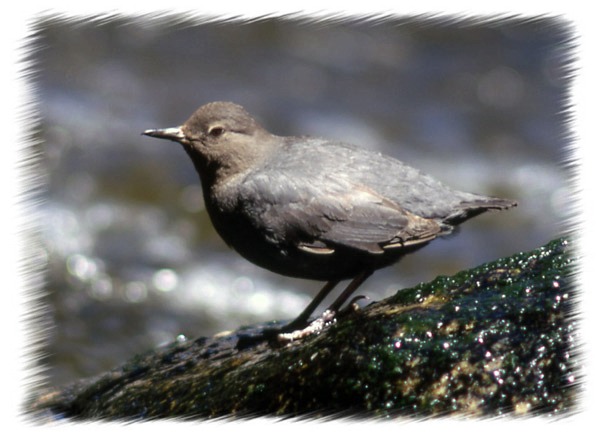
American Dipper - (Cinclus mexicanus)
1. Plump, slate gray bird; short tail.
2. Typical bobbing action as it stands on rocks, logs, etc. 3. Almost always associated with rushing streams. 4. Direct flight over stream with rapid wing-beats. 5. Somewhat smaller than an American robin. 6. Sexes similar. 7. Dipper Photos |
Food and Feeding American Dippers feed mainly on water insects. Fly fishermen in the West watch this bird very closely, for the dipper is skilled at catching insects and insect larva. Experienced fly fishermen have learned to duplicate the insect larvae that the dipper feeds on, hoping to increase their chances of catching a trout. The typical behavior of a dipper consists of bobbing up and down on the rocks in the middle of a creek or river. They are expert swimmers and can grub for insects by walking underwater, which they accomplish by grabbing onto rocks with their feet. |
Movement and Wintering American Dippers are found singly or in pairs. They are found in Yellowstone throughout the year. In the winter some dippers are forced to move to lower elevations in search of open water and available food. The lower end of the Gardner River is an excellent place to observe high concentrations of American Dippers in the winter. |
Interesting Facts The American Dipper is North America's only truly aquatic songbird. The genus Cinclus is derived from the family Cinclidae, the dipper family; mexicanus means Mexico. The range of the American Dipper is restricted to the mountains of western North America, from Panama to Alaska. The name dipper refers to this bird's unique bobbing or dipping behavior when it perches on a rock or log in a stream. American Dippers are well adapted to their water environment. They possess an extremely large preen, or oil, gland, keeping their feathers waterproof. They also have a moveable flap covering the nostrils, which keeps water out when they dive, and a nictitating membrane over the eyes, which keeps then clear of water droplets. In Britain, dippers are also commonly called "water ousels". |
Information from the book, "Birds of Yellowstone" by Terry McEneaney and from All About Birds
Black-billed Magpie

Black-billed Magpie - (Pica hudsonia)
1. The bird is black with white shoulders, a white belly, and iridescent dark blue-green wings and tail. 2. There are large white markings on the primaries, clearly visible in flight. 3. The feet and bill are black. 4. The tail is long and makes up half of the bird's length. 5. The adult Black-billed Magpie is 18–24 inches long and weighs 5-7.5 ounces. 6. Sexes similar. 7. Magpie Photos |
Food and Feeding The Black-billed Magpie is an opportunistic omnivore, eating many types of insects, carrion, seeds, rodents, berries, nuts, eggs, and also garbage and food from pets that are fed outside. Chicks are fed animal matter almost exclusively. Magpies typically forage on the ground, usually walking, sometimes hopping, and sometimes scratching with their feet to turn over ground litter. They sometimes land on large mammals, such as moose or elk, to pick at the ticks that often plague these animals. Black-billed Magpies are also known to make food caches in the ground, in scatter-hoarding fashion. To make a cache, the bird pushes or hammers its bill into the ground (or snow), forming a small hole into which it deposits the food items it was holding in a small pouch under its tongue. It may, however, then move the food to another location, particularly if other magpies are in the vicinity, watching. Cache robbing is fairly common so a magpie often makes several false caches before a real one. The final cache is covered with grass, leaves, or twigs. After this the bird cocks its head and stares at the cache, possibly to commit the site to memory. Such hoards are short-term; the food is usually recovered within several days, or the bird never returns. The bird relocates its caches by sight and also by smell; during cache robbing, smell is probably the primary cue. |
Movement and Wintering This species is mainly a permanent resident. Some birds may move short distances south or to lower elevations in winter, while others may wander east after the breeding season. The Black-billed Magpie often forms loose flocks outside of the breeding season. Dominance hierarchies may develop within such flocks. Dominants can steal food from subordinates. Aggressive interactions also occur at point sources of food. Surprisingly, young males are often dominant over - or maybe just tolerated by - adult males. |
Interesting Facts The most common calls of this bird are a nasal inquisitive "mag mag mag" or "yak yak yak", uttered in a much higher pitch than the European Magpie's. Many other calls also exist, such as begging calls by females to their mate or by young to their parents, and distress calls when seized by predators. When Lewis and Clark first encountered magpies in 1804 in South Dakota, they reported the birds as being very bold, entering tents or taking food from the hand. Magpies formerly followed American bison herds (from which they gleaned ticks and other insects), as well as the bands of Plains Indians that hunted the bison so they could scavenge carcasses. When the bison herds were devastated in the 1870s, magpies switched to cattle, and by the 1960s they had also moved into the emerging towns and cities of the North American West. Today Black-billed Magpies remain relatively tame in areas where they are not persecuted. However, they become very wary in areas where they are often shot at or disturbed. Especially during the first half of the 20th century, Black-billed Magpies were considered detrimental to game-bird populations (they sometimes steal bird eggs) and domestic stock (they sometimes peck at sores on cattle), and were systematically trapped or shot. Bounties of one cent per egg or two cents per head were offered in many states. In Idaho the death toll eventually amounted to an estimated 150,000. In 1933, 1,033 magpies were shot in Washington's Okanogan valley by two teams of bounty hunters. Many magpies also died from eating poison set out for coyotes and other predators. |
Information from Wikipedia
Yellowstone Canada Geese
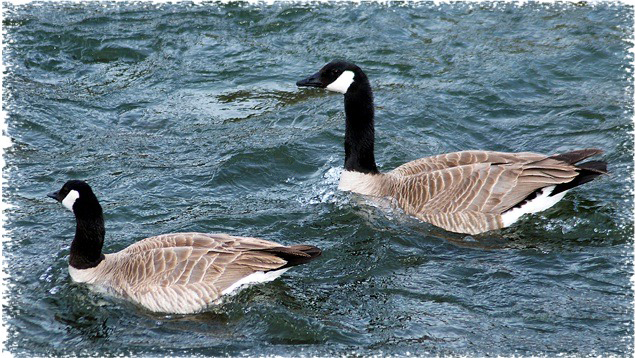
Canada Goose - (Branta canadensis) Identification Features
1. Large bird. 2. Black head and neck with a white chinstrap. 3. Brownish body. 4. Characteristic "honking" call. 5. Normally flies in a V-shape formation. 6. Sexes similar. |
Food and Feeding In spring and summer, geese concentrate their feeding on grasses and sedges, including skunk cabbage leaves and eelgrass. During fall and winter, they rely more on berries and seeds, including agricultural grains, and seem especially fond of blueberries. They're very efficient at removing kernels from dry corn cobs. |
Nest Description A large open cup on the ground, made of dry grasses, lichens, mosses, and other plant material, and lined with down and some body feathers. On the ground, usually on a muskrat mound or other slightly elevated site, near water. They prefer a spot from which they can have a fairly unobstructed view in many directions. Female selects the site and does much of nest construction. She adds down feathers and some body feathers beginning after the second egg is laid. She does all the incubation while her mate guards her and the nest. |
Behavior Canada Geese eat grain from fields, graze on grass, and dabble in shallow water by tipping forward and extending their necks underwater. During much of the year they associate in large flocks, and many of these birds may be related to one another. They mate for life with very low "divorce rates," and pairs remain together throughout the year. Geese mate "assortatively," larger birds choosing larger mates and smaller ones choosing smaller mates; in a given pair, the male is usually larger than the female. Most Canada Geese do not breed until their fourth year; less than 10 percent breed as yearlings, and most pair bonds are unstable until birds are at least two or three years old. |
Information from website All About Birds
Common Raven - Yellowstone National Park
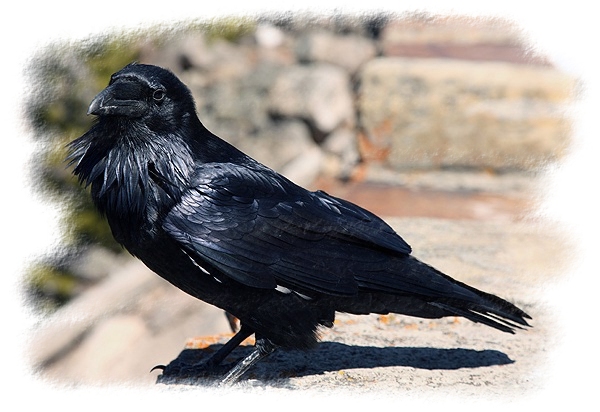
|
Common Raven -(Cotvus corax) Identification Features 1. Large, all black bird with stout bill. 2. Wedge-shaped tail, usually obvious in flight. 3. Soars more often than the crow. 4. Call is a low-pitched, drawn out CRA-A-A-K. 5. Slightly larger than a Mallard. 6. Sexes similar. 7. Raven Pictures. |
|
Food and Feeding The raven is omnivorous, meaning that it feeds on both plants and animals. Ecologically, the raven can be classified as a "raptor" because of its rapacious nature at times of obtaining carnivorous pray, although it is not a true bird of prey in the classical sense. Ravens in Yellowstone are often observed chasing other raptors or following mammalian predators to a potential food source. Another adaptation is its ability to find food in the middle of winter — they are often found in close proximity to ungulate herds, where they feed on carrion. |
|
Movement and Wintering Common Ravens are found in pairs, but more often in flocks. They are found in Yellowstone in every conceivable habitat throughout the year. Some ravens often move to lower elevations in the winter due to the scarcity of food at higher elevations. |
|
Interesting Facts Corus is a genus of the Corvid family that includes crows and ravens, and corax means "a croaker." The word raven, which refers to a large black bird with a loud hoarse call and noted for its plundering or rapacious habits, is derived from the old English word hraefn, which supposedly describes the cry of the bird. Ravens are perhaps the most successful of all the birds species that inhabit Yellowstone. Its success lies in its ability to adapt to humans, and live in a hostile environment, to eat a wide variety of food items, and to live in a wide variety of habitats. The raven is considered by many native cultures as a hero and a good omen. |
Information from the book, Birds of Yellowstone by Terry McEneaney
Dusky Grouse - Yellowstone National Park
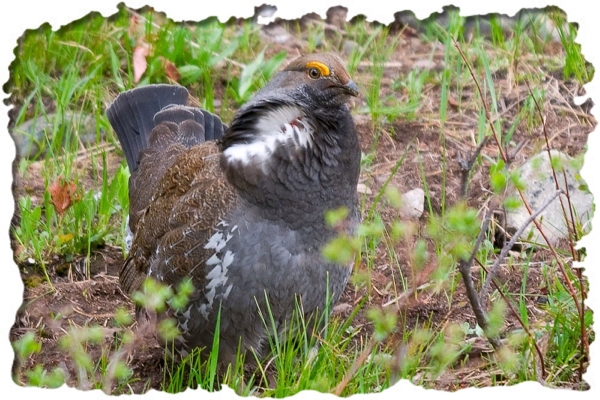
Dusky Grouse - (Dendragapus obscurus) Identification Features 1. Large chicken-like bird. 2. Dusky gray. 3. Dark gray band on tip of black tail. 4. Bare skin on side of male's neck purplish-red. 5. Plumage paler, in general, than Sooty Grouse. |
|
Description Dusky grouse (formerly known as blue grouse) are the second largest grouse in North America, measuring 15 to 12 inches in length. They are exceeded in size only by the sage grouse. Males weigh approximately three pounds and females and juveniles about two pounds. Males are a slate-gray or blue-gray, while females are more mottled brown. Both sexes have a pale gray terminal band on their rounded or fan-shaped tail, however the band is more distinct in males. White markings are present on the flanks and under the tail feathers. Feathering extends to the base of the middle toe. The eye comb of the male is yellow to orange. Females have smaller areas of bare skin over the eyes. Males have white feathers surrounding the cervical sacs. The white feathers and cervical sacs are absent in females. |
|
Food and Feeding In summer, Dusky Grouse feed on the ground on leaves, flowers, buds, berries, conifer needles, and insects. In winter, they forage in trees for needles of pines, firs, and other conifers. Young birds eat mostly insects, especially in the first 10 days of life. Vaccinium, also known as blueberry or grouse whortleberry, is an important diet component for adult males in the fall. |
Habitat In the breeding season Dusky Grouse inhabit open, relatively dry mixed and conifer forest from the ponderosa pine zone to the subalpine fir zone, and adjacent shrub-steppe, grassland, aspen groves, and alpine meadows. In lodgepole pine and Engelmann spruce forests at elevations above 5,000 feet, they may be largely, but not entirely, replaced by Spruce Grouse. They winter in dense conifer stands, often at a higher elevation than their breeding habitat. |
Information from All About Birds, BirdWeb, and Colorado Parks and Wildlife
Gray Jay - Yellowstone National Park
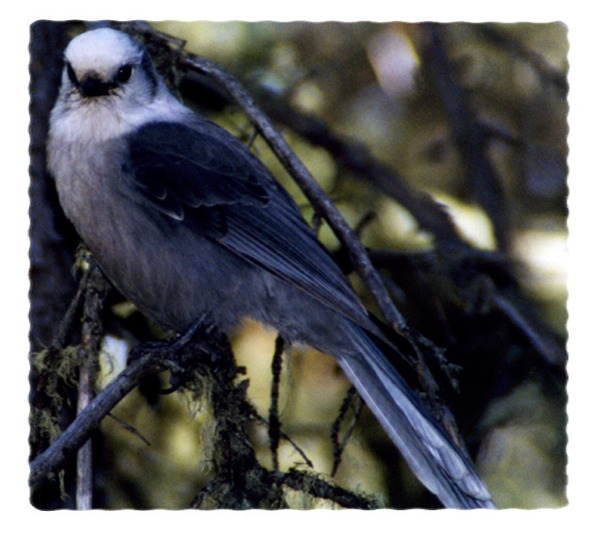
Gray Jay - (Perisoreus canadensis) Identification Features 1. Gray body. 2. Black feet and bill. 3. White forehead and crown. 4. Long tail; medium bill; no crest. 5. Flight: characteristically flap and glide. 6. Slightly larger than an American Robin. 7. Sexes similar. |
Food and Feeding The Gray Jay frequents campgrounds and picnic areas located in coniferous forests and key in on food on or near picnic tables. Besides scavenging food from humans, it has the ability to feed on a wide variety of food items, including insects, nuts, eggs, and even small nestling birds. During stressful periods, the jay returns to areas of stored food, or caches. In the winter it will occasionally feed on carrion. |
Movement and Wintering Gray Jays are often found in pairs or small flocks. They reside in Yellowstone throughout the year. In the winter they move to forested areas at slightly lower elevations, in search or food. |
Interesting Facts Perisoreus means "food storer," and canadenisi means Canada. This gray bird was previously known as the Canada Jay where it was first described. It is known by a variety of other common names. The one most commonly applied is "whiskey jack," a name used by hunters and trappers of the north woods. Whiskey jack had nothing to do with hard liquor; it was derived from the Indian name wis-ka-tjon, which was later anglicized to whiskey john and then to whiskey jack. Today the Gray Jay is also referred to as the "camp robber." It is extremely tame and unafraid of humans. It can be extremely quiet or very noisy, and it has the ability to produce a wide variety of calls and whistles. It is an excellent imitator of the calls of other birds, particularly those of the Red-tailed Hawk and the Northern Pygmy-Owl. |
Information from the book, Birds of Yellowstone by Terry McEneaney
Mountain Chickadee - Yellowstone National Park

Mountain Chickadee - (Parus gambeli) Identification Features 1. Tiny gray bird with black cap, eyestripe and bib. 2. White eyebrow and cheek. 3. Call: hoarse: Chick-a-dee-dee-dee. 4. Smaller than a House sparrow. 5. Sexes similar. 6. Mountain Chickadee Photos |
Food and Feeding The food of the Mountain Chickadee is a variety of small seeds and insects. This bird flies from tree to tree, actively calling as it collects food from the limbs and branches of each tree. |
Movement and Wintering Mountain Chickadees are often found in pairs or in small flocks. They are found more commonly in mountainous country at higher elevations. They reside in Yellowstone throughout the year. In the winter their number are lower and they often move to slightly lower elevations in search of food. |
Interesting Facts The genus Parus is derived from the family Paridae, which includes chickadees, titmice, and related species. The parids are small, round, plump birds with small, thin bills. The species gambeli refers to Dr. William Gambel, one of the leading field ornithologist in the mid-1800s. The name Chickadee is derived from the bird's call. Mountain Chickadees are more commonly found in conifers, while Black-capped Chickadees inhabit mixed or deciduous forests, usually at lower altitudes in Yellowstone. They are both extremely tame and unafraid of humans. |
Information from the book, Birds of Yellowstone by Terry McEneaney
Red-breasted Nuthatch - Yellowstone National Park
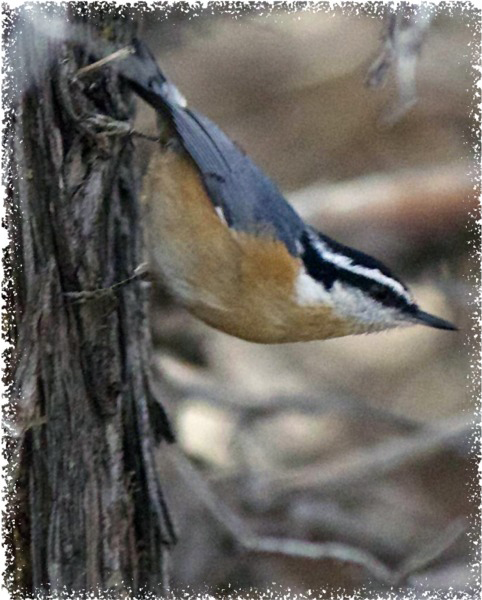
Red-breasted Nuthatch - (Sitta canadensis) Identification Features 1. A small, compact bird with a sharp expression accentuated by its long, pointed bill. 2. Very short tails and almost no neck. 3. The body is plump or barrel-chested. 4. Its short wings are very broad. 5. Blue-gray birds with strongly patterned heads. 6. A black cap and stripe through the eye broken up by a white stripe over the eye. 7. The underparts are rich rusty-cinnamon, paler in females. |
Food and Feeding In summer, Red-breasted Nuthatches eat mainly insects and other arthropods such as beetles, caterpillars, spiders, ants, and earwigs, and they raise their nestlings on these foods. In fall and winter they tend to eat conifer seeds, including seeds they cached earlier in the year. During outbreaks of spruce budworm, a forest pest, Red-breasted Nuthatches respond strongly to the plentiful food supply. When given the choice they tend to select the heaviest food item available; if these are too large to eat in one piece they typically jam them into bark and then hammer them open. |
Movement Red-breasted Nuthatches move quickly over trunks and branches probing for food in crevices and under flakes of bark. They creep up, down, and sideways without regard for which way is up, and they don't lean against their tail the way woodpeckers do. Flight is short and bouncy. |
Interesting Facts The Red-breasted Nuthatch collects resin globules from coniferous trees and plasters them around the entrance of its nest hole. It may carry the resin in its bill or on pieces of bark that it uses as an applicator. The male puts the resin primarily around the outside of the hole while the female puts it around the inside. The resin may help to keep out predators or competitors. The nuthatch avoids the resin by diving directly through the hole. During nest building, the Red-breasted Nuthatch is aggressive, chasing away other hole-nesting birds such as the House Wren, White-breasted Nuthatch, and Downy Woodpecker. A particularly feisty nuthatch may go after Yellow-rumped Warblers, House Finches, Violet-Green Swallows, and Cordilleran Flycatchers. |
Information from All About Birds
Trumpeter Swan - Yellowstone National Park
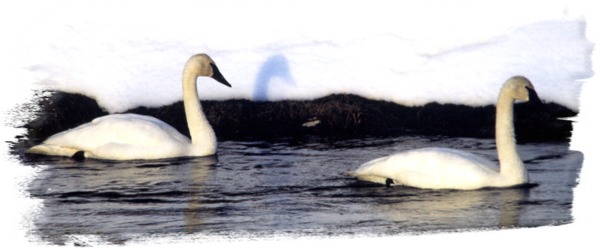
Trumpeter Swan - (Cygnus buccinator) Identification Features 1. Very large white bird with black bill and feet. 2. All white wings. 3. Young (cygnets) have grayish plumage. 4. Call a hollow, nasal honking. 5. Sexes similar. |
Food and Feeding Diet consists primarily of submergent vegetation and aquatic invertebrates. The swans prefer shallow, calm, or slow moving water for feeding, and they feed by dipping their heads under water. |
Movement and Wintering Trumpeter Swans are commonly found in the summer in pairs or in pairs with gray cygnets. In the winter, during stressful periods, Trumpeter Swans become more socialable and gather into large flocks. Yellowstone's resident adult swans do not move very far in the winter-their movements can best be described as nomadic, as they wander around looking for open water areas where food is available. In the winter, Yellowstone's swan population is composed of both nomadic residents and migrants. |
Interesting Facts Cygnus is a Latin word meaning swan, while buccinator means bugler or trumpeter. The Trumpeter Swan gets its name from its trumpet-like call. It is regarded as the largest of all North American wildfowl. John James Audubon cherished the primary feather of the Trumpeter Swan as one of the best quill pens for writing. The Trumpeter Swan as an endangered species, however, in the 1930s less than one hundred were believed to exist in the world. The regional summer population is currently less than 500 individuals. In the winter, due to the influx if migrants from northern latitudes, the regional population can be as high as 1,500 individuals. The male swan is called a cob, the female a pen, and young swans are called cygnets. |
Information from the book, Birds of Yellowstone by Terry McEneaney
Yellowstone Bird Check List this is an Adobe pdf file.
Click here to go to the Animal / Mammals Page.


| Yellowstone National Park WebCams | |||
|---|---|---|---|
| Old Faithful Live | All Old Faithful | Old Faithful Static | Old Faithful VC |
| North Entrance | Mt Washburn | Mammoth | YVO WebCam |
| Entrance Cities and Gateway Towns | |||
|---|---|---|---|
| Gardiner, Montana | Silver Gate, Montana | West Yellowstone, Montana | Cooke City, Montana |
| Livingston, Montana | Cody, Wyoming | Jackson Hole, Wyoming | Yellowstone National Park |

| Links | |
|---|---|
| The Great Outdoors Net | Great Outdoor Recreational Places |
| Gardiner, Montana | West Yellowstone, Montana |
 |  |